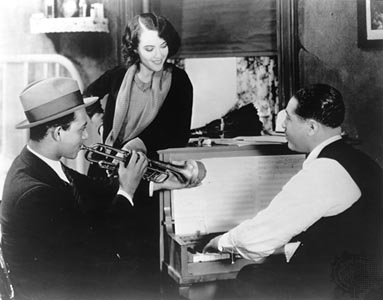
Does revolutionary music always go hand in hand with revolutionary technology?
The experience of the twentieth century would point to that: no rock recordings precede the invention of the electric guitar, but thereafter almost every single studio innovation of the next forty years would be driven by popular music.
But rock’s ability to inspire innovation pales by comparison with the pre-War achievements of jazz. Jazz was the first popular music to enjoy a genuinely world-wide following, and of course was the breakout form of black music, but there was so much more besides, as we’ll see incapsulated in just a few great Duke Ellington recordings.
Film
Ellington’s success at Harlem’s Cotton Club launched his career as an international artist, and coincided closely with the launch of the talking picture. The Jazz Singer of 1927 – the first movie with talking sequences – was followed less than two years later by an extraordinary short musical film featuring Ellington – Black and Tan Fantasy. It would be followed by quite a number of Ellington films over the next few years – Old Man Blues in 1930, Bundle of Blues in 1933, and Symphony in Black in 1935, but the 19 minutes of Black and Tan Fantasy were remarkable above all, climaxing as they did in one of the great jazz performances of all time. About half of this astonishing film – ten minutes or so – can be seen here:
Radio
Radio was, of course, the great twentieth century medium alongside moving pictures of all kinds. Later this week on the Garreteer we’ll feature one of the most musically remarkable of all radio commercials, a surreal piece of cinema swagger from Cab Calloway. Calloway, not Ellington, would be in at the gotterdammerung of pre-War Jazz, the great Stormy Weather. But it would be the Duke Ellington Orchestra’s broadcasts from the Cotton Club at the end of the 1920s that would set the stage.
Ellington was a genius: a dapper, unflappable genius who would come to boast friendship with every great musician and dandy of the age, from Gershwin through Rachmaninov to the Duke of Windsor. But none of this got him excused the racist treadmill that the other great names like Bessie Smith and Louis Armstrong were turned out onto by a white-dominated United States of America.
Here are two wire recordings of broadcasts made from the Cotton Club on April 12th, 1929. The atmosphere is superb: the music wonderful. But the introduction – by a man whose name let’s hope long forgotten – is excruciating. Ellington is the King of Jungle Music, the riproaring harmony hound..
Radio Part One
One of the disadvantages of an enthusiasm for pre-War jazz is that the quality of surviving recordings is so low compared with anything from the later 33rpm era. Even well-restored tracks lack something. So when a recording from the pre-War period slips through that does match post-War conditions and quality, it has the potential to open the music up in an entirely unexpected way.
Duke Ellington cut such a recording on the 3rd of February, 1932.
It was an accident, admittedly. RCA Victor’s technology at the time was such that they kept more than one microphone and recording apparatus at any given session: backups were needed embarrassingly often, as we’ll see shortly when we look at the production of an Ellington pre-War record. On this occasion, there were two microphones recording separately, and both versions were released as records.
Many years later, an enthusiast who found themselves in possession of both versions noticed that when played together, the combination of the two produced “acceptable stereo.” Acceptable stereo! These recordings, more than any other that survive, communicate to us just how good it must have been to hear the young Ellington and his orchestra at their youthful height. They are just astonishing:
Recording Music in the 1930s
Ellington was famous – infamous? for his attention to detail in the studio. We’ve seen him in action, however briefly, in Black and Tan Fantasy; here he is in 1937 – you can hear the transition into swing, a smoother, flatter music than the full-out jazz of pre-Wall Street Crash days – starring in a fascinating step-by-step walkthrough of the creation of a new 78 rpm recording. The vocalist is Ivy Anderson. Ten years later, but a World War away, Columbia would introduce the 33rpm long playing record, which Ellington would put to quite different uses as he cemented himself as America’s greatest twentieth century composer. But this is his last turn as a true innovator, his last real breath of youth, and it’s glorious.
It was (I think) a Kenny Ball version of Black and Tan Fantasy that got me interested in Ellington fifty years ago – that plus Chris Barber versions of Creole Love Call, Rockin’ in Rhythm and Mood Indigo.
Mind you, Teagarden apparently thought Ellington’s music overrated. I don’t know what his arguments were – maybe he just didn’t like the sound of it.
May I invite you to pursue this line of thought by considering Charlie Christian?